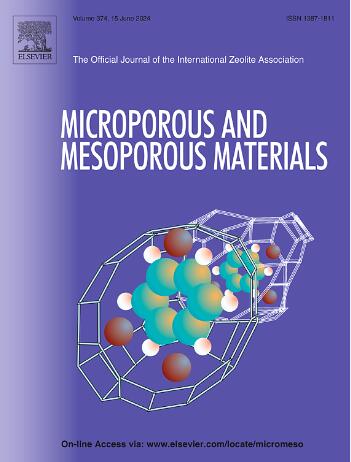ETL种子催化乙醇脱水加速合成铁素体纳米针
IF 4.7
3区 材料科学
Q1 CHEMISTRY, APPLIED
引用次数: 0
摘要
分子筛纳米结构在分子水平上的合理设计对分子筛在各种反应中的性能和催化性能有重要影响,尤其是醇制烃反应。然而,大多数合成方法涉及复杂和耗时的过程。为了解决这些挑战,开发一种新的合成方法,通过集成的一步快速合成方法来获得分层沸石,可能是一项有前途的研究贡献。本文报道了通过ETL沸石种子辅助的方法可以有效地加速层状FER沸石的结晶,从而减少合成时间。这种行为可以解释为,FER和ETL分子筛都含有相似的主要构建单元,即more,当使用ETL作为种子时,more可以帮助FER的形成。因此,可以直接从ETL种子的构建单元构建FER框架。此外,ETL种子的纳米棒状结构可以影响目标FER的形态,最终形成层次化的纳米针状特征。本文还系统地研究了合成的纳米针状层状fe在乙醇脱水中的催化活性,证明了所设计材料与传统材料相比的优势。本文章由计算机程序翻译,如有差异,请以英文原文为准。

Accelerated synthesis of ferrierite nanoneedles via the ETL seed-assisted approach for catalytic ethanol dehydration
The rational design of zeolite nanostructures at the molecular level significantly impacts their properties and catalytic performances in various reactions, especially alcohols-to-hydrocarbons. However, most synthesis methods involve complex and time-consuming processes. To address these challenges, developing a new synthesis method to obtain hierarchical zeolites via an integrated one-step and rapid synthesis approach could be a promising research contribution. Herein, we report that the crystallization of hierarchical FER zeolite can be effectively accelerated via the ETL zeolite seed-assisted approach, resulting in a decrease of synthesis time. This behavior can be explained by the fact that both FER and ETL zeolites contain similar main building units, namely mor, which can assist the formation of FER when using ETL as seeds. As a result, the FER framework can be directly constructed from the building units of the ETL seed. In addition, the nanorod-like structure of ETL seeds can affect the target FER morphology, eventually forming hierarchical nanoneedle features. The catalytic activities of the synthesized hierarchical FER with a nanoneedle shape were also systematically investigated in ethanol dehydration, demonstrating the advantages of the designed materials compared to the conventional one.
求助全文
通过发布文献求助,成功后即可免费获取论文全文。
去求助
来源期刊

Microporous and Mesoporous Materials
化学-材料科学:综合
CiteScore
10.70
自引率
5.80%
发文量
649
审稿时长
26 days
期刊介绍:
Microporous and Mesoporous Materials covers novel and significant aspects of porous solids classified as either microporous (pore size up to 2 nm) or mesoporous (pore size 2 to 50 nm). The porosity should have a specific impact on the material properties or application. Typical examples are zeolites and zeolite-like materials, pillared materials, clathrasils and clathrates, carbon molecular sieves, ordered mesoporous materials, organic/inorganic porous hybrid materials, or porous metal oxides. Both natural and synthetic porous materials are within the scope of the journal.
Topics which are particularly of interest include:
All aspects of natural microporous and mesoporous solids
The synthesis of crystalline or amorphous porous materials
The physico-chemical characterization of microporous and mesoporous solids, especially spectroscopic and microscopic
The modification of microporous and mesoporous solids, for example by ion exchange or solid-state reactions
All topics related to diffusion of mobile species in the pores of microporous and mesoporous materials
Adsorption (and other separation techniques) using microporous or mesoporous adsorbents
Catalysis by microporous and mesoporous materials
Host/guest interactions
Theoretical chemistry and modelling of host/guest interactions
All topics related to the application of microporous and mesoporous materials in industrial catalysis, separation technology, environmental protection, electrochemistry, membranes, sensors, optical devices, etc.
 求助内容:
求助内容: 应助结果提醒方式:
应助结果提醒方式:


